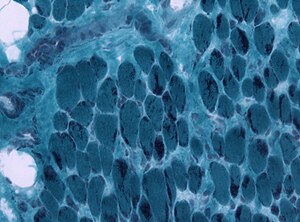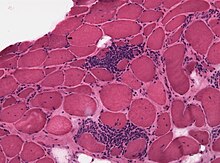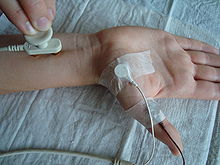Neuromuscular disease
| Neuromuscular disease | |
|---|---|
 | |
| Congenital nemaline myopathy (neuromuscular disorder) | |
| Specialty | Neurology, neuromuscular medicine, physical medicine and rehabilitation |
| Causes | Autoimmune disorders,[1] genetic disorders,[2] environmental factors[3] |
| Diagnostic method | Muscle electrophysiology tests, genetic testing |
| Treatment | Depends on the disorder; many currently have no cure[2] |
A neuromuscular disease is any disease affecting the peripheral nervous system (PNS),[a] the neuromuscular junctions, or skeletal muscles, all of which are components of the motor unit.[4] Damage to any of these structures can cause muscle atrophy and weakness. Issues with sensation can also occur.
Neuromuscular diseases can be acquired or
Signs and symptoms
Symptoms of neuromuscular disease may include numbness, paresthesia, muscle atrophy, a pseudoathletic appearance, exercise intolerance, myalgia (muscle pain), fasciculations (muscle twitches), myotonia (delayed muscle relaxation), hypotonia (lack of resistance to passive movement), fixed muscle weakness (a static symptom), or premature muscle fatigue (a dynamic symptom).[2][9][10][11]
Causes
Neuromuscular disease can be caused by
Diseases of the
Further causes of neuromuscular diseases are:

Inflammatory muscle disorders
- giant-cell arteritis (It often responds to prednisolone).[18]
- autoimmune condition in which the muscle is affected.[19]
- Rhabdomyolysis is the breakdown of muscular tissue due to any cause.[20]
Tumors
- Smooth muscle: leiomyoma (benign)[21]
- Striated muscle: rhabdomyoma (benign)[22]
Diagnosis

Diagnostic procedures that may reveal muscular disorders include direct clinical observations. This usually starts with the observation of bulk, possible atrophy or loss of muscle tone. Neuromuscular disease can also be diagnosed by various blood tests and using
Prognosis
Prognosis and management vary by disease.[citation needed]
See also
Notes
- ^ Lower motor neurons originate in the anterior horn of the spinal cord, a part of the central nervous system. However, the anterior horn is also part of the motor unit. Diseases that affect the anterior horn are classified as neuromuscular.
References
- ^ PMID 22379454.
- ^ a b c d "Neuromuscular Disorders: MedlinePlus". www.nlm.nih.gov. Retrieved 2016-04-24.
- ^ ISBN 9781447138341.
- ISBN 978-1-4614-6567-6.)
{{cite book}}: CS1 maint: location missing publisher (link - ^ "GeneTable of Neuromuscular Disorders".
- S2CID 235822532.
- .
- ISBN 978-1-4614-6567-6.)
{{cite book}}: CS1 maint: location missing publisher (link - ^ "Myopathy Information Page: National Institute of Neurological Disorders and Stroke (NINDS)". www.ninds.nih.gov. Archived from the original on 2016-04-27. Retrieved 2016-04-24.
- PMID 28778933.
- ISSN 2108-2219.
- S2CID 22600065.
- ^ Myasthenia Gravis at eMedicine
- PMID 12754327.
- ^ Lambert-Eaton Myasthenic Syndrome (LEMS) at eMedicine
- ISBN 9780323296359.
- ^ "Muscular Dystrophy Information Page: National Institute of Neurological Disorders and Stroke (NINDS)". www.ninds.nih.gov. Retrieved 2016-04-24.
- ^ Liaison, Janet Austin, Office of Communications and Public. "Polymyalgia Rheumatica and Giant Cell Arteritis". www.niams.nih.gov. Archived from the original on 2016-05-25. Retrieved 2016-04-24.
{{cite web}}: CS1 maint: multiple names: authors list (link) - ^ Polymyositis at eMedicine
- ^ MedlinePlus Encyclopedia: Rhabdomyolysis
- ^ Leiomyoma at eMedicine
- ^ Rhabdomyomas at eMedicine
- ^ PMID 22938875.
- ISBN 978-0124171275.
- ^ Electromyography and Nerve Conduction Studies at eMedicine
Further reading
- Wokke, John H. J.; Doorn, Pieter A. van; Hoogendijk, Jessica E.; Visser, Marianne de (2013-03-07). Neuromuscular Disease: A Case-Based Approach. Cambridge University Press. ISBN 9781107328044.
- Ambrosino, N; Carpene, N; Gherardi, M (2009). "Chronic respiratory care for neuromuscular diseases in adults". European Respiratory Journal. 34 (2): 444–451. PMID 19648521.
